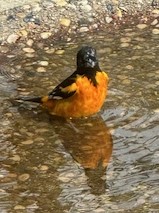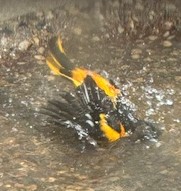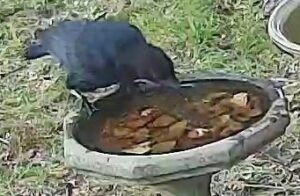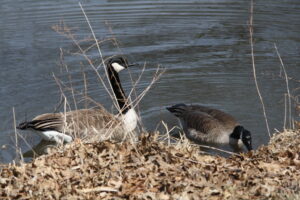All the new things going on!
Spring is the time for new beginnings, arrivals, and wild swings of weather. If you have been watching the birdfeeder cam over the last few weeks, you have seen the feeders swaying in the wind – which does not seem to deter the birds at all.
Here is what is happening in our yard and also some additions I have made to the website:
The birdbath cam has been turned on and is now streaming to the website. I have added a hummingbird feeder and a Baltimore Oriole feeder to the area of this livestream. This is a work in progress so there will be changes as the weeks pass. In May, I will be adding plants – plants that should draw hummingbirds, butterflies, and moths. I will list them and talk about their care in the Public Forum under Gardening for Birds. This area is also an experiment in that both feeders are close to the birdbath and will the hummingbirds and orioles be comfortable with that? Use the feeders? Will there be territory and dominance issues? Time will tell…… Right now, the main bathers are House Sparrows, House Finches, Brown-headed Cowbirds, cardinals, and robins. That will change as the weeks go by. All the birds like this birdbath and will use it. For the next few weeks, the best time to watch the birdbath cam is mid afternoon to sunset. Only a few birds are using the birdbath right now, but the number of birds will increase as the weeks go by and the weather gets warmer. Right now, we still do not have all our summer residents – some are still in migration.


The Baltimore Orioles are back. Cleon thought he heard one a few days ago, but we actually saw a male yesterday afternoon at their feeder. We had the feeder stocked with jelly all last summer and they used it regularly – males, females, and their offspring. It was also used by the several Gray Catbirds that live in our long shrub border along our driveway and forage in the adjacent large flower garden. The catbirds have yet to arrive – we expect them in a week or so. We moved the feeder so you can now see it on the birdbath cam. Hopefully this location will work for the birds.
The hummingbirds are back. Within an hour of my putting up this feeder, a male was drinking from it. However, he did not come again – at least not while I was watching. He may have been still migrating – rested, ate, and moved on. I did see a male hummingbird at the other birdfeeders yesterday afternoon – he buzzed around them, sat for a moment on a nearby twig, then flew off. The hummingbirds in our yard have always been Ruby-throated Hummingbirds. There are records of a few other species of hummingbirds in Illinois, but we have never seen any in our yard.

The Brown Thrashers are back. We saw one taking a bath in the big birdbath a few days ago. In the past several years, we have had two pairs in, under, and around our long shrub border and foraging in the adjacent large flower garden. These thrashers are almost daily bathers – most often later in the afternoon. The mated pairs will come to the birdbath together. We should soon start to hear them singing – a favorite singing perch has always been the roof of our next door neighbor’s house. Thrashers are larger birds, but they are secretive and do not like to be out in the open too long. One way for you to to know they are here is to look at the sidewalk at the birdbath. Thrashers forage in the mulch and throw it every which way to unearth something tasty. Once they are here and established, I will have to sweep almost every morning. So it you look at the birdbath cam early in the morning or in the afternoon and there is mulch on the sidewalk – the thrashers have been busy!
I have added a container of lint to the birdfeeder area. If you look to the right on your screen, you will see it hanging from the post. My cousin Jean gave me a feeder for Christmas that will hold a corn cob or suet. As I do not use either in spring and summer, I commandeered the feeder to hold lint – and it works very well. Some birds will use lint to line their nests. This is the first time I have ever placed lint close to feeders – normally, I place it on the other side of the house well away from the feeders and the stash I provide is generally used. So placing it this close to the feeders is an experiment and we will see if it works. Hopefully it does and you will be able to watch them pull lint and fly off with it in their beaks. Hummingbirds also use lint so fingers crossed!
The small birdbath is filled – it is right next to the larger birdbath that is near the birdfeeders. Cleon had it turned upside-down behind the larger birdbath for the entire winter and was quite surprised that when he turned it over to clean and fill it, there were ants all over the underside. He turned it right-side up and left it there for several days so the ants could completely disperse and find a new home. Ants are a valuable part of our wildlife refuge that is throughout our yard. And from a birder’s point of view – one of the main foods for Northern Flickers – we have a pair. Ants help keep everything balanced.
 The Zen Garden is ready for the crows! Those of you who watched the birdfeeder cam last summer and fall saw our Zen Gardening crows. There were two of them and they rearranged the pebbles and rocks in the small bird bath almost on a daily basis. I did get a video of them and if you go to Videos and scroll down the list, you will find it. Fascinating behavior! Right now, the crows that live here are nesting in the riparian woodland across the lake from us and are busy raising families – no time for Zen! We will only rarely see them right now in our yard. But once the young fledge and are on their own – probably in May or June – keep an eye on this small birdbath and see if these crows come back to play with the rocks – and maybe meditate? Who knows what goes on in the mind of a crow? These are intelligent, clever birds.
The Zen Garden is ready for the crows! Those of you who watched the birdfeeder cam last summer and fall saw our Zen Gardening crows. There were two of them and they rearranged the pebbles and rocks in the small bird bath almost on a daily basis. I did get a video of them and if you go to Videos and scroll down the list, you will find it. Fascinating behavior! Right now, the crows that live here are nesting in the riparian woodland across the lake from us and are busy raising families – no time for Zen! We will only rarely see them right now in our yard. But once the young fledge and are on their own – probably in May or June – keep an eye on this small birdbath and see if these crows come back to play with the rocks – and maybe meditate? Who knows what goes on in the mind of a crow? These are intelligent, clever birds.
The warblers are migrating through our neighborhood. Although you will probably not see them on either livestream, if you have your volume turned up, you may hear their soft, high calls to each other. For the past 2 days, we have had a small flock of about 20 warblers – Yellow-rumped Warblers and Palm Warblers. They are very active in our trees – foraging – and will leave probably after this weekend of rain. Flocks of warblers will come through here over the next 4 weeks or so.
 The Canada Geese have been slow to set up territories and build nests this year. In fact, right now on our small lake, we have only one or two pair and that is a big change. Normally this time of year, we have a good-sized group of about 30-40 geese and within that group, probably 8-10 mated pairs and all are jockeying for nest sites. We have a prime nest site on the point of our peninsula where we have had a nest every year we have lived here. These nests are not always successful as we have raccoons, but this site has always been claimed and occupied.
The Canada Geese have been slow to set up territories and build nests this year. In fact, right now on our small lake, we have only one or two pair and that is a big change. Normally this time of year, we have a good-sized group of about 30-40 geese and within that group, probably 8-10 mated pairs and all are jockeying for nest sites. We have a prime nest site on the point of our peninsula where we have had a nest every year we have lived here. These nests are not always successful as we have raccoons, but this site has always been claimed and occupied.
This year, we have only had one big goose fight between 4 birds in the backyard and if you were watching the birdfeeder cam a few days ago, you might have witnessed it. Lots of chasing and they are LOUD. But that was it. The one pair has disappeared and the other pair has been swimming along our bank and occasionally coming to the feeders to eat underneath and then napping in the backyard. But, there is no sign of nest building anywhere on the lake. For the last 10 years, these geese have been nesting earlier and earlier – some as early as the last week in March. It could be the geese will still nest – they are just late this year. And we did have a very cold winter and early spring. That was also a change. Our winters – and especially the early springs – have been milder. This year, we have also had a lot of rain and the weather has been stormy with unrelenting wind day after day. One result being most farmers here in central Illinois are about 3-4 weeks late getting their corn planted. They cannot get into their fields – it has been too wet. The weather has certainly affected farmers and pushed their planting schedules way back. It may have also affected nesting of Canada Geese?
I have added two new sections to the Public Forum. The first new section is “American Robin Nest – Beginning 4/23/25.” A robin is building a nest right outside our kitchen window and Cleon and I will be watching it. I will post our observations and photos every few days so you can all see what is happening. If you have not already downloaded my free ebook on robins, please click on ebooks and fill out the order sheet. It will be sent to your email address immediately. I am getting excellent feedback on it – people are enjoying it. I am so glad! (If you have a question about this or trouble ordering, contact me at lindahendricksspence@birdingbeyondthefieldguide.com)
The second new section is “”Are you observing any nests?” This is where you can share with all of us what you are observing and include photos if you wish. Spring is such a wonderful time of year to watch birds! They are so busy setting up territories, finding mates, building nests, and raising young. You can wake up every morning to singing – the best way to start a day! For those of you who are new to birding, remember not to get close to a nest. Robins are most often quite used to people, but many birds are skittish and there are some birds that will abandon their nests if they feel threatened – including if there are eggs. My recommendation is to observe from a distance and use your binoculars.

